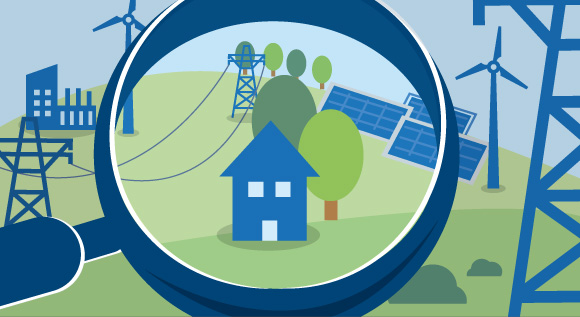How does CO2 pricing actually work?
In 2021, carbon pricing will be introduced in the transport and heat sectors. The new system is the centrepiece of the Federal Government's Climate Protection Programme. To find out the how the carbon pricing system has worked up to now, and how transport and heat are to be incorporated, please read on.
 © BMWi
© BMWiWidening of emissions trading: carbon emissions to be priced in the transport and heating sectors.
Under the European Emissions Trading Scheme, in place since 2005, energy and industrial companies have had to purchase allowances for the emissions they produce from energy generation, and can trade these with one another at market-based prices. Heat is the only sector in which a proportion of the allowances allocated are free.
The number of new emissions allowances made available each year is constantly declining. As the prices paid for traded allowances increase, so too does the economic pressure on carbon-intensive power plants. This makes the electricity produced by these plants more expensive than electricity from less carbon-intensive power generation (e.g. from renewable sources or combined heat and power plants). The allowance price thus turns long-term European emission reduction targets into a price signal for companies. In this way, emissions can play a role in business decisions.
The European Emissions Trading Scheme is the European Union's key instrument for reducing harmful greenhouse gas emissions and is the most important lever for implementing the EU's climate goals. The scheme covers almost half of all greenhouse gas emissions generated by Europe. In November 2017, the European Commission, Council and Parliament agreed a reform for the fourth trading period (2021 to 2030). For more information on this reform, please click here.
Germany to introduce new national emissions trading scheme from 2021
As is already the case with the energy industry and energy-intensive industries within the scope of the European ETS, prices for carbon emissions are to be introduced for the transport and housing industries. The aim of the new scheme is to help Germany achieve its climate targets. The principle behind the national scheme is the same: the more it costs to pump carbon emissions into the atmosphere, the greater the incentive against doing so. Although the energy industry is responsible for the majority of carbon emissions in Germany, carbon emissions are also released in transport and heating.
How the fields of transport and heating are to be incorporated
The new carbon pricing system for heat and transport to be launched in 2021 is the centrepiece of the Federal Government's 2030 Climate Action Programme. The system is principally based on the emission budgets set for Germany by the EU and the carbon targets for the transport, buildings and energy sectors in the Federal Government's Climate Action Plan for 2050. It enables the upper limits of the carbon targets for the individual sectors to be controlled and reduced each year. Companies that bring heating and fuel into circulation have to buy certificates (digital papers) which serve as 'pollution rights'. For every tonne of heating oil, liquid gas, natural gas, coal, petrol or diesel, a certain number of certificates must be surrendered by the supplier. The criteria for which suppliers are obliged to acquire and surrender certificates are still to be set down in law. The exact number of certificates that must be surrendered depends on the carbon content of the fuels. Certificates are paid by the suppliers who then pass the costs on to the consumers. The fewer certificates that are issued, the higher the price and the greater the incentive to cut back carbon emissions or invest in carbon-saving technologies. This market mechanism is also designed to ensure that investments are made where they are particularly cost-effective.
National emissions trading system to start with a fixed price per tonne of carbon emissions
The trading of certificates can cause prices to fluctuate over time. In order to give consumers time to adjust to the higher fuel costs, the new national emissions trading system (nEHS) launching in 2021 will start with a fixed price for each tonne of carbon released that is set in advance. This will initially be 10 euros per tonne and will rise to 35 euros per tonne by 2025. After that, the price is to be determined by the market as far as possible. In order to ensure that it does not rise too quickly however, a minimum and a maximum price have been set for 2026. In 2025, it will be decided whether it would be useful or indeed necessary to establish a price corridor for after 2026.
Falling electricity costs, a higher rate of commuter tax allowances and cheaper train journeys
The Federal Government plans to invest the revenue from carbon pricing in climate protection measures and to pass it on to citizens by reducing costs in other areas. As of 2021, the renewable energy surcharge will be reduced (which will also reduce electricity costs), commuters will receive a higher travel allowance, and a reduced VAT rate can make longer train journeys cheaper.
Further information
- Key components of the Climate Action Programme: Carbon pricing (available in German only)
- Video blog on the Climate Package by Federal Minister for Economic Affairs and Energy, Mr Peter Altmaier (available in German only)
- Article by the Federal Ministry for Economic Affairs and Energy: The EU emissions trading system – essential for the energy transition

